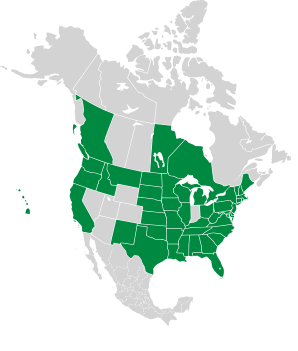Trifolium incarnatum L. var. elatius Gibelli & Belli

|
Trifolium incarnatum L. Crimson clover
Crimson clover is a native of western and southern Europe that has become naturalized throughout much of North America, after its introduction here. Depending upon who you talk to, it is planted as natural fertilizer, planted as an ornamental (sometimes in lawns), or an evil invasive. Whatever. The flowers sure are pretty. Here is a comparison among red, white, alsike, and crimson clovers: |
|||||||||||||||||||||||||||||
|
| |||||||||||||||||||||||||||||
Trifolium repens |
Trifolium hybridum |
You are here Trifolium incarnatum |
|||||||||||||||||||||||||||
|---|---|---|---|---|---|---|---|---|---|---|---|---|---|---|---|---|---|---|---|---|---|---|---|---|---|---|---|---|---|
| Common Name |  |
 |
 |
||||||||||||||||||||||||||
| Plant | Plant stems are 4-16″ (10-40 cm) long, but often lying on their sides, so these clovers are usually close to the ground | 1-2′ (30-60 cm) tall, typically somewhat smaller than red clover and larger than white clover. It has multiple hairless, fairly flexible stems | 1½′ (50 cm) high. | ||||||||||||||||||||||||||
| Flowers | On flower stalks 1-4″ (2.5-10 cm) long. Flowerheads are ½-1¼″ (1.3-3.2 cm) around, rounded, white, sometimes pinkish | ½-¾″ (1.3-1.9 cm) around, and may be pink on the bottom, grading to white on the top; or pink throughout. The shade of pink is lighter than with red clover | Deep red, forming rounded conical flowerheads about 1″ (2.5 cm) tall and ⅝″ (1.7 cm) around. Flowering occurs during April to May. | ||||||||||||||||||||||||||
| Leaves | In groups of 3. Leaflets are oval, ½-1¼″ (1.3-3.2 cm) long, with a slight indentation at the end. Each leaflet has a pale green "V" close to the base and slightly toothed leaf edges | In groups of three, each about ¾″ (2 cm) long, and attached directly to the stem that supports the leaf cluster. Leaves are oval-shaped, with smooth-appearing edges that have tiny teeth, and no chevrons | Leaves are round or oval, in groups of three, each roughly at right angles to the others. | ||||||||||||||||||||||||||
| Range/ Zones |
|
|
|
||||||||||||||||||||||||||
| Habitats | Waste ground, pastures, open fields, roadsides, railroads | Moist meadows near woodlands, pastures, abandoned fields, and roadsides | |||||||||||||||||||||||||||
| Type | Wild | Wild | Wild | ||||||||||||||||||||||||||
| Occurrence | Very common | Common, but less so than red and white clovers | |||||||||||||||||||||||||||
Identification: Plants are up to 1½′ (50 cm) high. Like other clovers, leaves are round or oval, in groups of three, each roughly at right angles to the others. Also like other clovers, these plants have roots that work together with bacteria to trap atmospheric nitrogen and convert it to usable nutrition, allowing them to grow in nutritionally poor soils. They are sometimes intentionally planted to improve soil nutrition. Flowers are deep red, forming rounded conical flowerheads about 1″ (2.5 cm) tall and ⅝″ (1.7 cm) around. Flowering occurs during April to May.
Online References:
Plants for a Future, a resource and information centre for edible and otherwise useful plants
Trifolium incarnatum L. var. elatius Gibelli & Belli
Trifolium incarnatum description by Thomas H. Kent, last updated 6 May 2023.
© FloraFinder.org. All rights reserved.
5/25/2008 · Memphis, Tennessee · By Tim Chandler 
Range:
